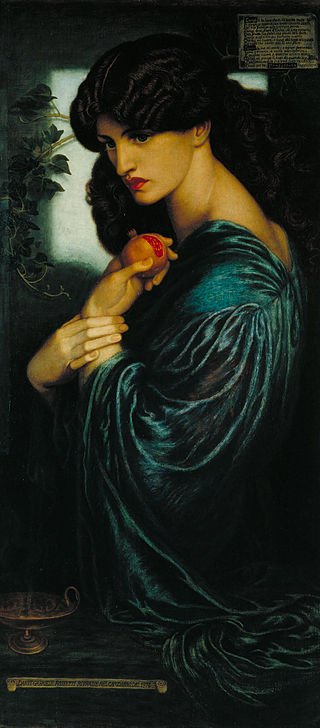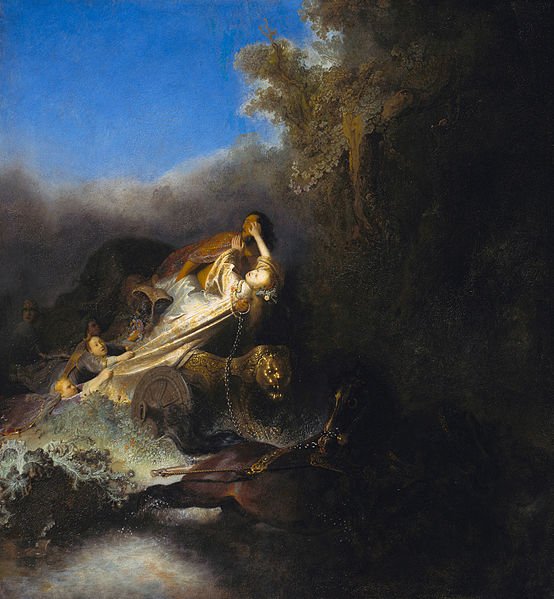Persephone: The Queen of the Underworld and Goddess of Spring
“Discover the chilling secrets of Persephone, the goddess who rules both the beauty of spring and the darkness of the underworld!”

Persephone is a captivating figure in Greek mythology, embodying the duality of life and death. As the daughter of Demeter, the goddess of the harvest, and Zeus, king of the gods, Persephone is often depicted as a radiant young woman, her beauty reflecting the blossoming flowers and greenery of spring. Her long, flowing hair is adorned with wreaths of flowers, and her attire is both regal and delicate, befitting her role as a goddess who moves between two worlds. Yet, beneath her graceful exterior lies a profound strength, a reflection of her reign over the shadowy realms of the dead.
Bio: Persephone’s story is one of transformation and profound significance in Greek mythology. As the beloved daughter of Demeter, she was once a carefree maiden who roamed the meadows, gathering flowers with her companions. However, her life took a dramatic turn when Hades, the god of the underworld, abducted her to be his queen. In the underworld, Persephone’s role shifted from that of a vibrant goddess of life to the powerful and enigmatic Queen of the Dead.
Persephone’s dual role as both the bringer of spring and the queen of the underworld represents the cycle of life, death, and rebirth. Her annual descent into the underworld and return to the earth’s surface symbolize the changing seasons—winter’s death and spring’s renewal. During the months she spends in the underworld, the earth experiences barren cold as Demeter mourns her absence. When she returns, her mother rejoices, and the earth bursts into bloom.
As a deity, Persephone’s purpose is to maintain the balance between life and death. She serves as a mediator between the mortal world and the afterlife, ensuring that the natural cycles of birth, death, and rebirth continue. While she was initially taken against her will, Persephone has come to embrace her role, finding a sense of power and identity as the queen of the underworld.
Persephone’s motivations are deeply tied to her love for her mother and her duty as a goddess. She wishes to bring life and beauty to the earth through the renewal of spring while also fulfilling her responsibilities in the underworld, where she ensures that the dead are honored and the cycle of life continues. Her existence is a blend of light and darkness, and through her, the ancient Greeks found meaning in the natural rhythms of the world. Ultimately, Persephone seeks to harmonize the dual aspects of her identity, achieving a balance that reflects the natural order of the cosmos.

Persephone is Goddess of the Underworld, wife of Hades, the beautiful daughter of Demeter and Zeus.
- Pantheon: Greek Pantheon
- Deity Title: Queen of the Underworld, Goddess of Spring and Rebirth
- Deity Symbol: Pomegranate, Torch, Flowers (particularly Narcissus and Poppy)
- Home Plane: Underworld (Hades’ Realm), also associated with the Plane of Arborea (Olympian Glades)
- Deity Level: Intermediate Deity
- Alignment: Lawful Neutral (with Neutral Good tendencies when in the mortal world)
- Aliases: Kore, Proserpina (Roman)
- Superior: Demeter (in the realm of the living), Hades (in the Underworld)
- Traditional Allies: Demeter, Hades, Hermes (as a guide of souls), Orpheus (in certain myths)
- Traditional Foes: Thanatos (Death in some myths), Mortals who defy the natural order (i.e., avoiding death or disturbing the seasons)
- Divine Artifact: The Pomegranate Seeds, which bind her to the Underworld
- Servants: Charon (the Ferryman), Hecate (in some versions), Erinyes (Furies)
- Servitor Creatures: Cerberus, Shades of the Underworld, Nymphs of the Underworld
- Sacred Animal: Bat, Black Ram, and Serpent
- Manifestations: A gentle breeze that brings the scent of spring, sudden growth of flowers in unlikely places, the feel of a warm hand in a cold place (symbolizing her dual nature)
- Signs of Favor: An early spring, unexpected blooming of flowers, the discovery of a single pomegranate in winter
- Worshipers: Farmers, Women (especially those desiring children), Anyone seeking peace after death, Those seeking to understand the balance of life and death
- Cleric Alignments: Lawful Neutral, Neutral, Neutral Good, Lawful Good
- Specialty Priests: Priestesses of Persephone, who often serve as intermediaries between life and death, overseeing funerals and seasonal festivals
- Holy Days: The Eleusinian Mysteries, the Thesmophoria (celebrating the bond between Demeter and Persephone)
- Portfolio: Life, Death, Rebirth, Seasons, Agriculture, Fertility, Transition from Maidenhood to Womanhood
- Domains: Life, Death, Nature, Grave
- Favored Weapon: Sickle or Scythe (symbolic of the harvest and the cycle of life and death)
- Favored Class: Druid, Cleric
- Favored Race: Humans, Dryads, Naiads
- Duties of the Priesthood: Ensure the seasonal rituals are observed, guide souls to rest, maintain the balance between life and death, comfort the grieving, and preside over rites of passage
- Major Cult/Temple Sites: Eleusis (site of the Eleusinian Mysteries), Enna (in Sicily, where she was said to have been abducted by Hades), Various sacred groves and caves associated with the Underworld
- Benefits: Blessings of fertility and harvest, guidance in the afterlife, protection against untimely death, and wisdom of the natural cycles
- Significant Others: Hades (husband), Demeter (mother)
The Lore of the Gods Book One: The Greek Gods
Lead Designers Steven Creech and Kevin Ruesch Lead Editor Steven Schend Creative Director Jim Butler Art Director Todd Morasch Artwork Aaron D. Siddal

Persephone’s wedding story provided the division of the seasons, giving us the sweetness of spring and the bitterness of winter. Hades did not woo the beautiful Persephone but rather abducted her while playing and picking flowers with Oceanus’s daughters and took her to his underground kingdom. After much protest, Persephone came to love the cold-blooded king of the Underworld but her mother, Demeter, stricken with depression, neglected her duties and allowed no sprout to grow and demonstrated her anger by punishing the earths inhabitants with bitter cold and blustering winds.
Until Persephone returned to her mother’s side, the earth would suffer. Zeus, noticing this, appealed to Hades. On his behalf Hermes entered the kingdom of Hades and negotiated a compromise between the (usually cold and selfish) Hades and the (usually loving and caring) Demeter. However, Hades tricked Persephone into eating six seeds from a pomegranate, thereby binding her to the Underworld, because no one can eat or drink in Hades and then leave. All involved agreed that Persephone would to spend 6 months of the year with her husband Hades , and the other half the year with her mother, Demeter.
Persephone, Goddess of Spring and Queen of the Underworld
Large Celestial (Goddess), Neutral
Armor Class: 30 (Divine Shield)
Hit Points: 600 (40d12+320)
Speed: 60 ft., 120 ft. (Fly), 60 ft. (Swim)
| STR | DEX | CON | INT | WIS | CHA |
|---|---|---|---|---|---|
| 30 (+10) | 24 (+7) | 28 (+9) | 22 (+6) | 30 (+10) | 32 (+11) |
Saving Throws: Dex +15, Con +17, Wis +18, Cha +19
Skills: Insight +18, Nature +14, Perception +18, Persuasion +19, Religion +14, Survival +18
Senses: Truesight 120 ft., Darkvision 120 ft., Passive Perception 28
Languages: All, Telepathy 120 ft.
Challenge Rating: 32 (225,000 XP)
Divine Abilities
- Divine Shield: Persephone is surrounded by an aura of divine protection that grants her resistance to all damage types and immunity to necrotic and poison damage.
- Death’s Embrace (Recharge 5-6): As an action, Persephone can envelop a target in a sphere of necrotic energy. The target must succeed on a DC 27 Constitution saving throw or take 120 (40d10) necrotic damage and become incapacitated for 1 minute. On a successful save, the target takes half damage and is not incapacitated.
- Spring’s Blessing (Recharge 5-6): Persephone can touch a target and restore up to 300 hit points or remove any curse, disease, or condition affecting them. Additionally, the target gains the benefits of the Greater Restoration spell.
Spellcasting
Persephone is a 30th-level spellcaster. Her spellcasting ability is Charisma (spell save DC 27, +19 to hit with spell attacks). She has the following spells prepared:
- Cantrips (at will): Guidance, Prestidigitation, Thaumaturgy
- 1st level (4 slots): Cure Wounds, Entangle, Faerie Fire
- 2nd level (3 slots): Lesser Restoration, Moonbeam, Pass Without Trace
- 3rd level (3 slots): Dispel Magic, Protection from Energy, Sleet Storm
- 4th level (3 slots): Blight, Divination, Greater Invisibility
- 5th level (3 slots): Cloudkill, Contagion, Greater Restoration
- 6th level (2 slots): Mass Suggestion, True Seeing
- 7th level (2 slots): Plane Shift, Regenerate
- 8th level (1 slot): Earthquake, Power Word Stun
- 9th level (1 slot): Foresight, Power Word Kill
Actions
- Pomegranate Burst (Recharge 5-6): As an action, Persephone can release a burst of magical pomegranate seeds in a 60-foot radius. Each creature in that area must make a DC 27 Dexterity saving throw, taking 70 (20d6) radiant damage on a failed save, or half as much damage on a successful one. The burst also restores 70 hit points to allies within the radius.
- Queen’s Wrath: Melee Weapon Attack: +19 to hit, reach 10 ft., one target. Hit: 60 (8d10 + 10) radiant damage plus 30 (6d10) necrotic damage.
- Spring’s Embrace (Recharge 5-6): As an action, Persephone can summon an aura of life and renewal in a 120-foot radius. All friendly creatures in the aura regain 100 hit points and are cured of all diseases and conditions. Enemies in the aura must make a DC 27 Constitution saving throw or take 60 (12d10) radiant damage.
Legendary Actions
Persephone can take 3 legendary actions, choosing from the options below. Only one legendary action option can be used at a time and only at the end of another creature’s turn. Persephone regains spent legendary actions at the start of her turn.
- Blossom Strike: Persephone makes one Queen’s Wrath attack.
- Divine Renewal: Persephone uses Spring’s Embrace.
- Summon Spirits (Costs 2 Actions): Persephone summons 1d4 + 1 nymphs or dryads that appear in unoccupied spaces within 60 feet of her. They act immediately after Persephone in the initiative order.
Regional Effects
The region within 1 mile of Persephone’s presence is affected by the following effects:
- Spring’s Awakening: The area experiences an eternal spring; plants flourish, and the weather is always mild and pleasant.
- Echoes of the Underworld: Ghostly apparitions occasionally manifest and can provide guidance or warnings to those who encounter them.
- Balance of Life and Death: Creatures that die within this region are instantly transported to the Underworld, unless prevented by powerful magic.
Magic Items
- Crown of the Queen: Grants Persephone advantage on saving throws against spells and magical effects. It also allows her to cast Plane Shift once per day without expending a spell slot.
- Staff of the Underworld: Functions as a +3 quarterstaff that deals an additional 2d6 necrotic damage on a hit. It also allows Persephone to cast Earthquake once per long rest.
- Pomegranate of Life: This artifact allows Persephone to use Greater Restoration and Wish once per week.
Currently in the World

In the heart of the ancient world, Persephone moves with quiet grace, her every step a blend of sorrow and strength. As the daughter of Demeter, she was once known only as the goddess of spring, a radiant figure who brought life to the earth. Yet, her fate took a darker turn when Hades, the lord of the underworld, abducted her, claiming her as his queen. Now, she stands as a figure of duality, bridging the realms of life and death, and her influence ripples through the world in ways both seen and unseen.
Persephone’s existence is one of cycles, mirroring the eternal rhythm of nature. Each year, she descends into the underworld, the land of shadows and spirits, where she reigns alongside Hades. During these months, the earth above falls into a deep slumber, as Demeter’s grief withers the fields and blights the harvests. The world grows cold and barren, a reflection of the queen’s absence. But this is not merely a time of mourning; it is also a time of reflection and preparation, as Persephone gathers the souls of the departed and guides them to their final rest.
Despite the darkness that surrounds her, Persephone is not a passive figure. She wields her power with a quiet determination, ensuring that the balance between life and death is maintained. Her rule in the underworld is firm but just, and she commands the respect of the spirits who dwell there. She is no longer the frightened girl who was taken against her will; she is a queen, a force to be reckoned with, and her word is law in the land of the dead.
When the time comes for her return to the surface, the earth rejoices. Flowers bloom in her wake, and the fields once again burst with life. She moves through the world, her presence a signal that the long winter is over. But even as she brings new life to the earth, there is a lingering sadness in her eyes, a reminder of the shadowy realm she must return to. Her joy is tempered by the knowledge that her time in the light is fleeting, and soon she will be called back to the underworld.
As the centuries pass, Persephone’s influence extends beyond the natural world. She becomes a figure of myth and legend, her story told and retold in the songs and poems of the ancient Greeks. Her image is carved into the walls of temples, and her name is invoked by those seeking her favor. Yet, she remains distant, a figure of both beauty and sorrow, whose true nature is known only to a few.
During the rise and fall of empires, Persephone watches from her shadowy throne, her gaze ever turned toward the world above. She witnesses the triumphs and tragedies of humanity, the wars and the plagues, the births and the deaths. She sees the growth of new philosophies and ideologies that slowly reshape the world, and she feels the ebb and flow of her own influence. But she is not forgotten. In secret, in the hidden places of the world, there are those who still honor her, who remember her as the goddess who walks between worlds.
In the 1450s, as the Renaissance begins to dawn in Europe, Persephone’s story takes on new life. Scholars and artists rediscover the myths of ancient Greece, and her image is once again brought to the forefront. She is depicted in paintings and sculptures, her dual nature explored in new and profound ways. Some see her as a symbol of rebirth, a figure of hope in a time of great change. Others are drawn to the darkness within her, the queen who rules over death itself.
Throughout it all, Persephone remains constant, her role unchanged by the passing of time. She is the queen of the underworld, the bringer of spring, the goddess who embodies the cycle of life and death. Her desires are simple, yet profound: to maintain the balance, to ensure that the natural order is preserved, and to find peace in her dual existence. Though she is pulled between two worlds, Persephone seeks harmony within herself, a harmony that reflects the eternal cycles of the cosmos. And so, with each passing year, she returns to the surface, bringing life and light to the world once more, before descending back into the shadows, where she continues her reign over the realm of the dead.

 Buy me a coffee
Buy me a coffee